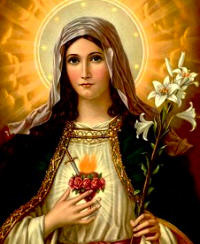 The writings of St. Irenaeus entitle him to a high place among the fathers of the Church, for they not only laid the foundations of Christian theology but, by exposing and refuting the errors of the gnostics, they delivered the Catholic faith from the real danger of the doctrines of those heretics.
The writings of St. Irenaeus entitle him to a high place among the fathers of the Church, for they not only laid the foundations of Christian theology but, by exposing and refuting the errors of the gnostics, they delivered the Catholic faith from the real danger of the doctrines of those heretics.
Irenaeus was probably born about the year 125, in one of those maritime provinces of Asia Minor where the memory of the Apostles was still cherished and where Christians were numerous. He was most influenced by St. Polycarp, who had known the Apostles or their immediate disciples.
Many Asian priests and missionaries brought the gospel to the pagan Gauls and founded a local church. To this church of Lyons, Irenaeus came to serve as a priest under its first bishop, St. Pothinus. In the year 177, Irenaeus was sent to Rome. This mission explains how it was that he was not called upon to share in the martyrdom of St. Pothinus during the terrible persecution in Lyons.
When Irenaeus returned to Lyons, it was to occupy the vacant bishopric. By this time, the persecution was over. It was the spread of gnosticism in Gaul, and the ravages it was making among the Christians of his diocese, that inspired him to undertake the task of exposing its errors. He produced a treatise in five books in which he sets forth fully the inner doctrines of the various sects, and afterwards contrasts them with the teaching of the Apostles and the text of the Holy Scripture. His work, written in Greek but quickly translated to Latin, was widely circulated and succeeded in dealing a death-blow to gnosticism. At any rate, from that time onwards, it ceased to offer a serious menace to the Catholic faith.
The date of death of St. Irenaeus is not known, but it is believed to be in the year 202. His remains were buried in a crypt under the altar of what was then called the church of St. John, but was later known by the name of St. Irenaeus himself. This tomb or shrine was destroyed by the Calvinists in 1562, and all trace of his relics seems to have perished.
— Source: www.catholic.org
 Historically, devotion to the Heart of Mary grew up in parallel, but at a lesser intensity than that of devotion to the Heart of Jesus, only starting to become more prominent during the time of St. John Eudes. John Eudes was born in 1601 in Normandy, France. He entered the Congregation of the Oratory of France, founded in 1611 by Cardinal de Berulle and was ordained to the priesthood on Dec. 20, 1625.
Historically, devotion to the Heart of Mary grew up in parallel, but at a lesser intensity than that of devotion to the Heart of Jesus, only starting to become more prominent during the time of St. John Eudes. John Eudes was born in 1601 in Normandy, France. He entered the Congregation of the Oratory of France, founded in 1611 by Cardinal de Berulle and was ordained to the priesthood on Dec. 20, 1625.
St. John brought people to love Christ and the Virgin Mary by speaking tirelessly about their hearts, the sign of the love God shows for us and the communion to which we are called.
To offer them liturgical worship, he composed Masses and offices in their honor and had the first Feast of the Holy Heart of Mary celebrated on Feb. 8, 1648, at Autun, France, and the Feast of the Heart of Jesus celebrated on Oct. 20, 1672.
He died on Aug. 19, 1680, and was canonized by Pope Pius XI on May 31, 1925.
Nevertheless, it was not until after the Apparitions at Rue du Bac concerning the "Miraculous Medal" made to Catherine Labouré in 1830, and the establishment of a society dedicated to the Immaculate Heart of Mary at the Church of Our Lady of Victories in Paris in 1836, that this particular devotion became well known.
Since then devotion to the Immaculate Heart of Mary has gradually grown more widespread in the Church, particularly since the apparitions at Fatima.
The main difference between the devotions to the hearts of Jesus and Mary is that the one concerned with Jesus emphasizes His divine heart as being full of love for mankind, but with this love for the most part being ignored or rejected, while devotion to Mary's heart is essentially concerned with the love that her heart has for Jesus, for God.
Therefore, it is not an end in itself, so the love of her heart is meant to be a model for the way we should love God. The fact that her heart is immaculate, that is sinless, means that she is the only fully human person who is able to really love God in the way that He should be loved.
Honoring Mary's Immaculate Heart is really just another way of honoring Mary as the person chosen to be the Mother of God, recognizing her extraordinary holiness and the immense love she bestowed on Jesus as His mother, the person called to share in and cooperate in His redemptive sufferings.
— Catholic News Agency

